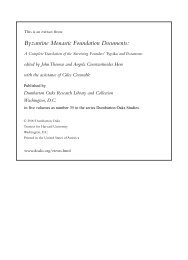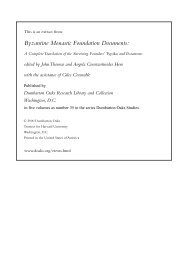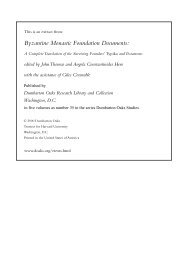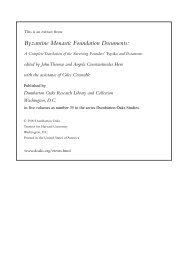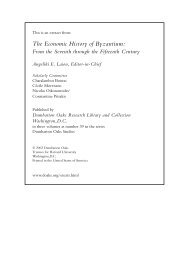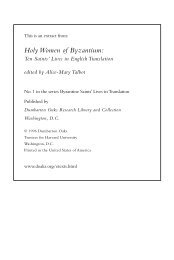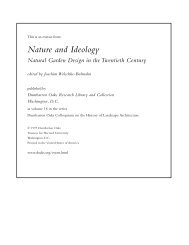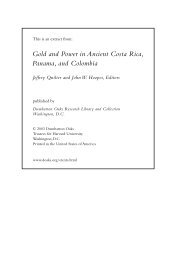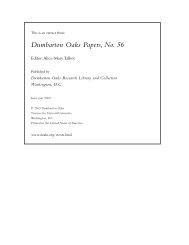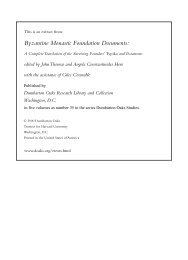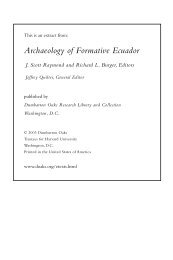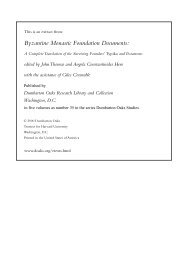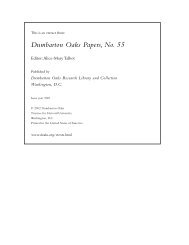Changing Economic Patterns in Latin Romania - Dumbarton Oaks
Changing Economic Patterns in Latin Romania - Dumbarton Oaks
Changing Economic Patterns in Latin Romania - Dumbarton Oaks
Create successful ePaper yourself
Turn your PDF publications into a flip-book with our unique Google optimized e-Paper software.
David Jacoby [ 209 ]<br />
aga<strong>in</strong> to state <strong>in</strong>tervention from 1301 to 1324 by settl<strong>in</strong>g <strong>in</strong> its colonies of Coron and<br />
Modon 124 men-at-arms and craftsmen, among them woodworkers, metalworkers, and<br />
stonemasons, whose activities would support specific aspects of local defense or the servic<strong>in</strong>g<br />
of naval forces. All these settlers received an annual salary that ensured their service<br />
<strong>in</strong> the local militias, yet were allowed to work for a daily wage. With their respective<br />
families, their total number reached around four hundred people. 72 In the fourteenth<br />
century Venice sought to encourage foreign Lat<strong>in</strong>s to settle <strong>in</strong> its colonies and outposts<br />
of Lat<strong>in</strong> <strong>Romania</strong> by grant<strong>in</strong>g those who undertook to reside there for at least ten years<br />
the privileges of Venetian nationality <strong>in</strong> <strong>Romania</strong>, the status enjoyed by the subjects of<br />
Venice’s colonies. In addition to diplomatic protection, this status ensured them the same<br />
fiscal privileges as Venetian citizens <strong>in</strong> <strong>Romania</strong>, yet not <strong>in</strong> Venice itself; nor did it confer<br />
upon them the commercial advantages enjoyed by citizens. After the Black Death, Venice<br />
offered Lat<strong>in</strong>s settl<strong>in</strong>g <strong>in</strong> its colonies full Venetian citizenship. These measures had<br />
only very limited success. 73 It should be stressed that <strong>in</strong> Venetian territories the ongo<strong>in</strong>g<br />
process of spontaneous nonmilitary immigration of Venetians and other Lat<strong>in</strong>s, primarily<br />
motivated by private economic considerations, contributed far more than statesponsored<br />
immigration to Lat<strong>in</strong> demographic growth and resulted <strong>in</strong> a more diversified<br />
population. 74 This is clearly attested for Coron and Modon. 75<br />
Lat<strong>in</strong>s settl<strong>in</strong>g <strong>in</strong> Crete displayed an obvious preference for urban residence. Their<br />
heaviest concentration occurred <strong>in</strong> Candia, while others resided <strong>in</strong> Canea, Rethymno,<br />
Sitia, and some <strong>in</strong>land cities. The overwhelm<strong>in</strong>g majority of military settlers lived <strong>in</strong> a<br />
house <strong>in</strong> Candia or Canea that was <strong>in</strong>cluded <strong>in</strong> their tenement. Many of them were<br />
<strong>in</strong>volved <strong>in</strong> trade. 76 Nevertheless, some settlers, like Baldov<strong>in</strong>o Lombardo, apparently<br />
and 1299 military equipment for a total of some 500 men was sent to Crete: R. Cessi, ed., Deliberazioni del Maggior<br />
Consiglio di Venezia (Bologna, 1931–50), 3:354, no. 136, and 447, no. 45. S<strong>in</strong>ce it was to be distributed<br />
among Cretan fiefholders as well as burgenses, it does not provide any <strong>in</strong>dication about the number of the former,<br />
contrary to Thiriet, ibid., 430. For the decades follow<strong>in</strong>g the Black Death, Thiriet, ibid., 430, postulates<br />
that each member <strong>in</strong> the feudatories’ council had an average of five family dependents, without tak<strong>in</strong>g <strong>in</strong>to account<br />
that several members of the same household served on that council. On the territorial aspects of military<br />
settlement, see C. Maltezou, “Concessio Crete. Parathrh´sei" stà e“ggrafa dianomh'" feoúdwn stoù"<br />
prw´ tou" Benetoù" ajpoíkou" th'" Krh´th",” <strong>in</strong>Loibh` eij" mnh´mhn jAndréa G. Kalokairínou (Irakleion,<br />
1994), 107–31.<br />
72 See A. C. Hodgetts, “The Colonies of Coron and Modon under Venetian Adm<strong>in</strong>istration, 1204–1400”<br />
(Ph.D. diss., University of London, 1974), 151–52, 156, 355.<br />
73 Jacoby, “Etats,” 20. On the dist<strong>in</strong>ction between Venetian citizenship and nationality <strong>in</strong> <strong>Romania</strong>, see D. Jacoby,<br />
“Les Vénitiens naturalisés dans l’Empire byzant<strong>in</strong>: Un aspect de l’expansion de Venise en Romanie du<br />
XIIIe au milieu du XVe siècle,” TM 8 (1981): 217–35, esp. 219–20, repr. <strong>in</strong> idem, Studies on the Crusader States<br />
and on Venetian Expansion (Northampton, 1989), no. ix. On the practical implications, see Thiriet, Romanie,<br />
279–82.<br />
74 Both the demographic and military importance of state-sponsored settlement <strong>in</strong> Crete has been grossly<br />
overrated: see Jacoby, “Colonisation,” 312–13. The estimates of Lat<strong>in</strong> population <strong>in</strong> <strong>Romania</strong> suggested by Thiriet,<br />
“Nombres,” 428, are purely hypothetical. They are based on the cumulative number of merchants attested<br />
over a long period, which does obviously not reflect the number of Lat<strong>in</strong>s at any given moment. On variety of<br />
orig<strong>in</strong> among the settlers, see above, p. 208.<br />
75 See below, p. 222.<br />
76 Jacoby, “Etats,” 19. Note that <strong>in</strong> 1299 the Commune ordered that 110 crossbows out of a total of 430<br />
should be sent to Canea, which clearly po<strong>in</strong>ts to a much smaller number of Lat<strong>in</strong> settlers <strong>in</strong> this city: Cessi, Deliberazioni,<br />
3:447, no. 45. Accord<strong>in</strong>g to the rule, two Venetian brothers should have resided <strong>in</strong> the city of Canea




